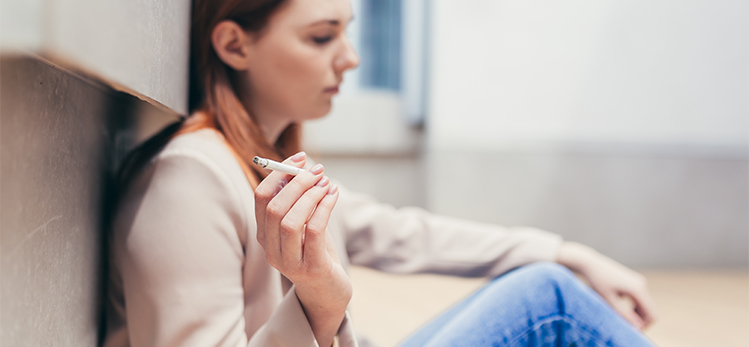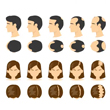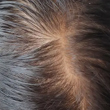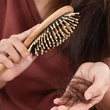Does Smoking Cause Hair Loss?
Tobacco smoke is directly related to hair loss because it contains harmful chemicals that can cause hair fall. Many studies have shown that smoking can be connected to hair loss in both men and women.
Although the exact reason for this relation is still unknown, according to experts, nicotine found in tobacco smoke depletes the nutrients needed for healthy hair growth. The nicotine present in tobacco smoke can cause constriction of blood vessels in the scalp, which further results in an inadequate supply of oxygen and nutrients to the scalp resulting in hair fall.
Hair loss is often genetic or hereditary, but smoking can make it worse. The nicotine in tobacco narrows blood vessels, which reduces blood flow to your scalp and puts your follicles under increased stress.
Increased Tobacco Smoke and Chemicals Exposure Causes Hairfall

The effects of smoking on hair loss are widespread, with some studies pointing to an increased risk of both men and women experiencing hair loss due to tobacco use. Research indicates that nicotine and other chemicals found in cigarettes result in increased hair loss.
Research performed by scientists concluded that smokers are twice as likely to suffer from moderate or severe hair loss than nonsmokers.
Nicotine is a vasoconstrictor, meaning it causes blood vessels to narrow, therefore limiting the amount of oxygen that reaches the scalp and follicles. The lack of oxygen can stunt follicle development and prevent proper growth of the hair shaft. Smokers often experience dull, lusterless hair with breakage along the length of the shafts, which may lead to excessive shedding of healthy strands.
Smoking impairs blood circulation to the scalp, resulting in a decrease in oxygen supply to the follicles of the scalp. This prevents the growth of healthy hair and makes it weak and brittle.
The harmful effect of smoking on hair is so severe that it can sometimes cause complete baldness if you continue with your bad habits of smoking or chewing tobacco after noticing this problem. So, precautionary measures should be taken from the first signs of thinning of hair.
Exposure to Tobacco Smoke Leads to Oxidative Stress
Hair loss is a common problem for many men and women. It may be caused by genetics, poor nutrition, or an underlying disease. Smoking is one of the leading risk factors for hair loss.
The effects of smoking on hair loss are likely the result of oxidative stress. When exposed to tobacco smoke, hair follicles are exposed to free radicals that lead to cell death and hair loss.
Oxidative stress is the imbalance between free radicals and antioxidants in a person's body. Free radicals can cause damage to cells and tissues, while antioxidants protect the body from this damage. Exposure to tobacco smoke leads to oxidative stress, which has been linked to hair loss
The reason smoking causes hair loss has to do with the chemical makeup of cigarettes. They contain nicotine, which is highly addictive; carbon monoxide; hydrogen cyanide; ammonia; formaldehyde; acetone; benzene; and polycyclic aromatic hydrocarbons (PAHs). All of these chemicals are toxic in high doses and can lead to significant oxidative stress in your body when you're exposed to them long enough.
Negative Impact on Blood Circulation Due to Tobacco Smoke
The blood vessels that supply the scalp with vital nutrients are constricted when you inhale tobacco smoke, making it more difficult for these nutrients to reach your hair follicles. One of these nutrients is iron, which plays an essential role in hair health because it helps form red blood cells that carry oxygen throughout your body.
Smoking can harm blood circulation due to the toxic chemicals it contains. These chemicals can damage blood vessels, resulting in a poor supply of nutrients and oxygen to the hair follicles.
Smoking also damages the blood vessels in your scalp, which can make it harder for nutrients to reach your hair follicles. The result is thinner hair with less pigment that has a shorter lifespan
The nicotine content in cigarettes reduces blood flow to the scalp. This causes a lot of stress on your follicles and accelerates hair loss. The other primary reason for smoking-related hair loss is due to poor lifestyle choices. Smokers often suffer from heart problems which cause a reduction in the supply of oxygen to the follicle.
It doesn't matter if you smoke now and then or even if you use an electronic cigarette or another vaping product instead of traditional cigarettes or cigars — any amount of smoking does damage. And just because you don't see immediate effects doesn't mean that your hair isn't being damaged on a microscopic level.
Smoking Can Cause a Series of Hair Issues
Smoking also affects the growth phase of hair by reducing the amount of time it stays in this phase. This causes premature ageing and can result in thinner, more brittle hair that is more likely to break off. When they quit smoking, smokers with thinning hair may experience even greater amounts of hair loss because their older strands are already brittle and prone to damage.
It is not just the nicotine that damages the hair follicles, and it is also the tar and other chemicals in cigarettes. Hair becomes brittle, dry, and prematurely grey.
Smoking is a well-known cause of premature greying of hair. Tobacco affects melanin production – the pigment responsible for skin and hair colour, resulting in the white or grey strands that become more common with age. The addictive nature of tobacco leads many smokers to light up before bed, often resulting in dry and brittle hair due to its exposure to oxygen.
Conclusion
By quitting smoking, you will improve your overall health, but you will also help reduce the amount of stress placed on your hair follicles. Your body will begin to repair itself and start producing healthier cells, including ones that will help prevent further hair loss.
If you are concerned about hair loss due to smoking, speak with a doctor about how quitting smoking could help restore your hair growth cycle.
Myth Busters HairFall

Androgenetic Alopecia - Everything You Need To Know
Have you been experiencing excessive hair fall over a prolonged period of time? It could be an early sign of androgenetic alopecia. It is a hair loss disorder common in both genders and can lead to progressive thinning and even baldness in some patients if not caught and treated early.

How To Make Hair Grow Faster For Men
A head full of healthy hair is a matter of confidence. Hair has its own mechanism of growing and shedding, and it is when this mechanism is thrown off that growth is hindered. Especially in the case of males, hair growth faces a lot of hiccups that can easily be managed.

Female Pattern Baldness - Causes & Treatments
Have you suddenly noticed an increase in the number of hair strands on your pillow in the morning? Or is your ponytail getting thinner by day? Well, you might be suffering from female pattern baldness. While that does sound scary, identifying it early on is key to treating this condition effectively. So keep reading to know what this is, how you can identify it, and most importantly, what treatments you can avail of to get your beautiful lustrous hair back.

What Are The Reasons For Hairfall?
Almost everyone experiences some amount of hair thinning over the years. Shedding around 50 to 100 single strands of hair per day is considered normal. However, losing more than 150 strands a day, experiencing sudden thinning, or developing circular bald patches on your scalp are reasons for concern. Hair loss occurs when new hair doesn’t grow fast enough to replace the amount of hair you lose daily. Hair can fall due to various reasons, with hereditary hair loss and poor nutrition being the most common hair fall reasons.

Expert Approved Tips For Hair Growth
What can be more debilitating than seeing hundreds of hair strands shedding from your scalp every time you brush your hair? Also, excessive molting occurs during seasonal changes that can be very stressful for you. Although it’s okay to lose between 50-100 strands every day, according to the American Academy of Dermatology, the problem occurs when you start shedding more than normal. But that doesn’t mean you have to feel helpless as there are ways to grow your hair back. Even if you are coping with baldness or alopecia, certain hair growth tips from dermatologists can come to your rescue. Read on to discover how these tips can be your savior when abnormal hair fall problems are in sight.
Trending Videos
+ 4 Sources
LMRC - GGI-CO-A2-DMA-300026127-300026127-WM-J21-282
© 2021 Dr. Reddy’s Laboratories Ltd. All rights reserved.